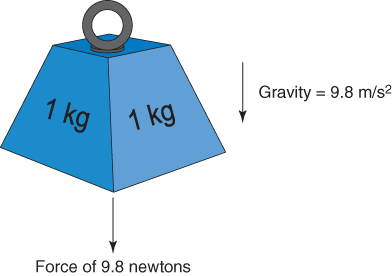3
Systems of units
Mass and weight
Mass is the measure of quantity of matter. The Système International (SI) unit of mass is the kilogram (kg).
Weight is a force. The SI unit of force is the newton (N). A particle of mass 1 kg is attracted towards the centre of the earth by a force of g newtons, where g is the acceleration due to gravity and has a value that varies slightly at different points on the earth’s surface. The value of g is about 9.8 m/s2, so a mass of 1 kg has a weight of about 9.8 newtons.
In everyday life the word ‘weight’ is often used instead of the word ‘mass’. A person’s weight is stated as being, say, 160 kg and the units indicate that mass rather than force is implied. In pharmacy, ‘weight’ is traditionally used in cases where ‘mass’ would be more appropriate and where it is obvious from the context and perhaps from the units, that a force is not intended. For example, tables of body weights are used and in the British Pharmacopoeia concentration ratios are stated as being w/v or w/w, i.e. weight in volume and weight in weight. In each case it is mass rather than weight that is being considered.
Rather than always using the correct term ‘mass’ in this book, ‘weight’ is used to conform with current pharmacy texts. No forces are used, so whenever ‘weight’ occurs, ‘mass’ is implied.

Metric units
The units most commonly used in pharmacy are those of volume and mass. The basic metric unit of volume is the litre (L or l) and the basic metric unit of mass is the gram (g). (The litre is also the SI unit of volume, but the SI unit of mass is the kilogram (kg).)
Prefixes are used to indicate multiples and submultiples of units. Those in general use are shown in Table 3.1 (see also Appendix 1). Thus, for the basic unit of the litre, one thousand litres are equal to 1 kL and one-thousandth of a litre is 1 mL. For the basic unit of the gram, one thousand grams are equal to 1 kg and one-thousandth of a gram is 1 mg.
In this book the only units we use with prefixes are kg, mg, kL and mL. For other multiples or submultiples we write the word in full (e.g. microlitre, microgram, megagram).
The metric system is based on the decimal system (see p. 11) so, as with decimals, we have a system of ‘place values’. Instead of column headings of units, hundreds, thousands, etc. we have the following.
Mass
| megagrams | – | – | kg | – | – | g | – | – | mg | – | – | micrograms | |
| Factors | 106 | 105 | 104 | 103 | 102 | 101 | 1 | 10−1 | 10−2 | 10−3 | 10−4 | 10−5 | 10−6 |
Volume
| megalitres | – | – | kL | – | – | L | – | – | mL | – | – | microlitres |
There are other metric prefixes for some of the headings that we have denoted by dashes, such as decigram and centigram, but we will not make use of them here (see Appendix 1).
Changing metric units
We can make use of ‘place values’ in changing metric units. Tackling the task in this way should avoid mistakes such as multiplying by a power of ten when division should have been carried out, or vice versa.



